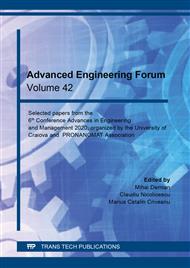[1]
R. Soyama, S. Ishii, and A. Fukase, The Development of Meal-Assistance Robot My Spoon,, Proceeding of the 8th International Conference on Rehabilitation Robotics, Daelon, Korea, pp.88-91, (2003).
DOI: 10.1007/10946978_8
Google Scholar
[2]
M. Topping, An Overview of the Development of Handy 1, a Rehabilitation Robot to Assist the Severely Disabled,, Journal of Intelligent and Robotic Systems 34, Kluwer Academic Publishers, p.253–263, (2002).
Google Scholar
[3]
NEATER, User Manual Instructions. Release date 15-11-(2013).
Google Scholar
[4]
Hermann, R.; Phalangas, A.; Mahoney, R. & Alexander, M., Powered Feeding Devices: An Evaluation of Three Models, Arch Phys Med Rehabil, Vol. 80, p.1237–1242, (1999).
DOI: 10.1016/s0003-9993(99)90022-9
Google Scholar
[5]
Topping, M. & Smith, J., The Development of HANDY 1, a Robotic System to Assist the Severely Disabled. International Conference on Rehabilitation Robotics. California. USA. pp.95-105. (1999).
DOI: 10.3233/tad-1999-10203
Google Scholar
[6]
Soyama, R.; Ishii, S. & Fukase, A., The Development of Meal-assistance Robot MySpoon, International Conference on Rehabilitation Robotics, Daejeon, Korea, p.88–91, (2003).
Google Scholar
[7]
Guglielmelli, E.; Lauro, G.; Chiarugi, F.; Giachetti, G.; Perrella, Y.; Pisetta, A. & Scoglio, A., Self-feeding Apparatus, US Patent2009/0104004. (2009).
Google Scholar
[8]
Pourmohammadali, H.; Kofman, J. & Khajepour, A., Design of a Multiple-user Intelligent Feeding Robot for Elderly and Disabled People, Master Thesis, University of Waterloo, Ontario, Canada. (2007).
Google Scholar
[9]
W. K. Song and J. Kim, Novel Assistive Robot for Self-Feeding,, Korea National Rehabilitation Research Institute, Korea National Rehabilitation Center, Korea, pp.43-60. (2012).
Google Scholar
[10]
Song, W.-K.; Kim, J.; An, K.-O.; Lee, I.-H.; Song, W.-J. & Lee, B.-S. New Dual-Arm Assistive Robot for Self-Feeding. Second International Symposium on Quality of Life Technology, Las Vegas, USA. pp.152-159. (2010).
Google Scholar
[11]
M. Ceccarelli, H. Gu, Trajectory planning for a 1-dof clutched robotic arm,, Robotica, Cambridge University Press, vol. 29, pp.745-756, (2011).
DOI: 10.1017/s0263574710000603
Google Scholar
[12]
Copilusi C., M. Kaur, Ceccarelli M. Lab Experiences with LARM Clutched Arm for Assisting Disabled People,, New Trends in Mechanism and Machine Science Mechanisms and Machine Science Volume 24. pp.603-611. (2014).
DOI: 10.1007/978-3-319-09411-3_64
Google Scholar
[13]
Klippel S., Seeholzer T., CONTEMPLAS, User Manual. Kempten, Germany. (2013).
Google Scholar


